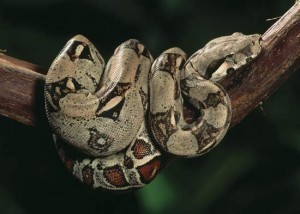Biggest Snake
The green anaconda is the biggest snake known in the world at the present. It is a boa species that is non-venomous and they are commonly found in the South American continent. This snake can reach to the length of six to seven meters or 19.8 to 23 feet. The heaviest specimen found for green anacondas weighs about 250 kilograms.
It is a boa species that is non-venomous and they are commonly found in the South American continent. This snake can reach to the length of six to seven meters or 19.8 to 23 feet. The heaviest specimen found for green anacondas weighs about 250 kilograms.
The color pattern of the green anaconda is composed of an olive green background that is overlaid with black blotches on the entire body length of the snake. Its head has a unique orange-yellow stripe on both sides which is narrower in comparison to the rest of its body. Its eyes are located high on the head which allows it to see above the water while swimming underneath without the need to expose its entire body.
Geographic Range
The species of the biggest snake are usually found in South America especially in the countries located on the eastern side of the Andes. These countries are Venezuela, Colombia, Ecuador, the Guianas, Bolivia, Brazil, Peru, and the Trinidad Island.
Common Names
The green anaconda is commonly called a water boa, anaconda, or common anaconda. The local names of the biggest snake include the following: ‘matatoro’ in Spanish which means ‘bull killer’, ‘sucuri’ in Native American and ‘yakumama’ in Peruvian that both mean ‘mother of the water’, and ‘huille’ or ‘huilla’ in Trinidad.
Behavior of the Biggest Snake
In general, green anacondas are nocturnal and love to spend most of their lifetime in or around watery areas. That is the reason why they are also called as the water boa since they spend more of their time in water compared to other boa species. These snakes are absolutely slow and sluggish when they travel on land due to their enormous body size. However, when they are in water, they have the capacity to move with great speed in any depths. They have the skill to float on the water surface but their nose is just barely poking out over the water surface.
Feeding
As the biggest snake, green anacondas are using constriction to overpower their prey. A hungry anaconda will grab its prey using its jaws and then coil around the prey using its large body. It will then constrict until the prey becomes suffocated and dead.
Since they are aquatic in nature, they have a wide selection of prey. They take in animals that they can overpower easily like birds, fish, other reptiles, and some kinds of mammals. Those very large green anacondas can consume huge preys like deer, tapir, other snakes, capybara, jaguars, and caimans. However, feeding on large preys are not done habitually. Cannibalism among the world’s biggest snake is also evident because there are recorded instances wherein larger female anacondas are consuming the smaller male of their kind.





